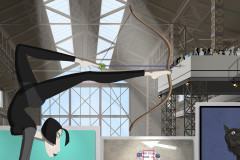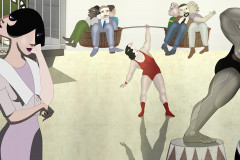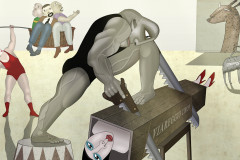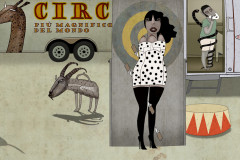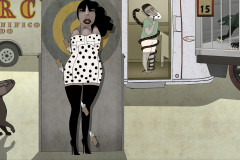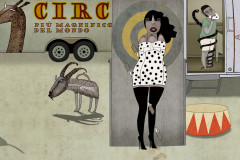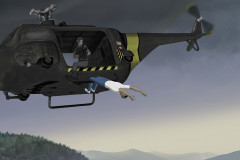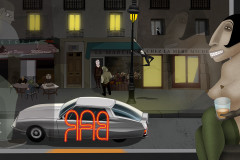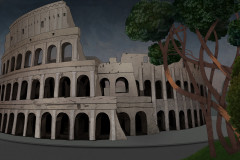Mi itt, Magyarországon talán a budapesti Nagycirkuszra gondolunk először, ha meghalljuk azt, hogy „cirkusz”. Máshol azonban a jellegzetes csíkos cirkuszi sátrak ugranak be az embereknek, és a harsány zene, ami már egy órával az előadás kezdete előtt csalogatni kezdi a település lakóit. Magyarország ugyanis azon kevés országok közé tartozik Európában, ahol állandó játszóhelyű cirkusz épült fel, és ma is működik. Európa középső és keleti részén Budapesten kívül csak Münchenben és Bukarestben van állandó kőcirkusz. Ráadásul a Fővárosi Nagycirkusz az egyetlen olyan kőcirkusz Európában, amely egész évben és a hét minden napján nyitva van.
A ma jól ismert cirkuszi sátor meglepő módon csak a 19. század végén, az USA-ban jelent meg, majd a 20. század elején Európában is. Addig minden új helyszínen, ahova megérkezett a cirkusz, a társulatnak fel kellett húznia egy ideiglenes bódét – de az is megesett, hogy a helyi színház épületében vagy egyszerűen szabad ég alatt játszottak.
A 20. század első felében vidéken sok helyütt csak a vándorló vidámparkok (vurstlik) és a vándorcirkuszok jelentették a látványosságot. Nem volt még tévé, színház is csak a városban. Sőt, még a negyvenes években is akadtak olyan települések, ahol elektromosság sem volt. Zenekar játszotta az élőzenét a cirkuszi előadás közben, és a társulat háromszor-négyszer is megismételhette egymás utáni napokon a műsort, hiszen azok a nézők is eljöttek újra, akik már látták az előadást.
Az utazó cirkuszművészek élete látszólag irigylésre méltó, hiszen bejárják a világ számos városát. De aki komolyan veszi a szakmáját, és eleget gyakorol, annak bizony nemigen marad ideje csavarogni az előadások után. És a cirkuszi kocsikban vagy vagonokban is inkább romantikusak a lakókörülmények, mint kényelmesek. Fudi, azaz Zsilák György, az ismert magyar zsonglőr így emlékezett vissza egy interjúban arra, amikor a hatvanas években meghívták egy amerikai vendégszereplésre: „Tudtuk, hogy 8 dollár 40 a napidíjunk, és kapunk lakást, de amikor megláttuk a vonatot, fel sem akartunk rá szállni. A fülkékben szinte csak az ágyak fértek el. Akinek nem volt felesége, azt az egyedülálló fiúknak fenntartott kocsikban szállásolták el. A házaspárok két méterszer két méteres fülkékben laktak, amiket papírvékonyságú falak választottak el egymástól. Egy szezon tizenegy hónapig tartott, ezalatt negyvenkét városban léptünk fel. A szezon január 6-án indult, és november 28-ig tartott. Voltak olyan utak, amikor két napig folyamatosan ment a vonat.”
Circus in Stone and Canvas: Hungary’s Place in a Moving Tradition
Here in Hungary, when we hear the word “circus,” we often think first of the Budapest Capital Circus (Fővárosi Nagycirkusz). Elsewhere, people are more likely to picture the iconic striped tents and the blaring music that begins drawing in the crowd an hour before showtime. That’s because Hungary is one of the few countries in Europe where a permanent, brick-and-mortar circus venue was built—and still operates today. In Central and Eastern Europe, outside of Budapest, only Munich and Bucharest have similar permanent circus buildings. Moreover, Budapest’s Capital Circus is the only one in Europe that is open year-round, every day of the week.
Surprisingly, the now-familiar circus tent didn’t appear until the late 19th century, first in the United States and only later in Europe in the early 20th century. Before that, each time a circus arrived in a new town, the troupe had to set up temporary wooden structures—or, in some cases, they performed in local theaters or simply under the open sky.
In the first half of the 20th century, traveling fairs and circuses were often the only entertainment available in rural areas. There was no television, and theaters were found only in larger towns. As late as the 1940s, some villages still lacked electricity. Circus performances were accompanied by live music played by in-house bands, and shows were often repeated three or four days in a row—since audiences would gladly return for a second or third viewing.
The life of a traveling circus performer might seem enviable—they get to see the world. But those who take their craft seriously and train diligently rarely have time to explore after the show. Life in circus wagons or train compartments is more romantic than comfortable. Hungarian juggler György Zsilák, known as Fudi, recalled in an interview what it was like to tour the U.S. in the 1960s:
“We knew our daily allowance was $8.40 and that we’d be given housing, but when we saw the train, we didn’t even want to get on. The compartments barely had space for beds. Single men were placed in designated cars; married couples lived in two-by-two-meter cabins, separated only by paper-thin walls. The season lasted eleven months. We performed in forty-two cities, from January 6 to November 28. On some stretches, the train ran nonstop for two days.”
A life full of wonder, hard work, and constant motion—that’s the world of the circus, whether under stone domes or canvas tents.








